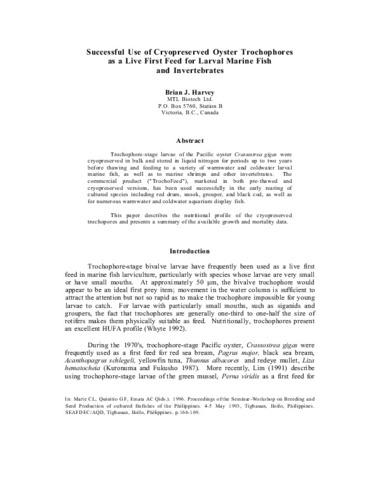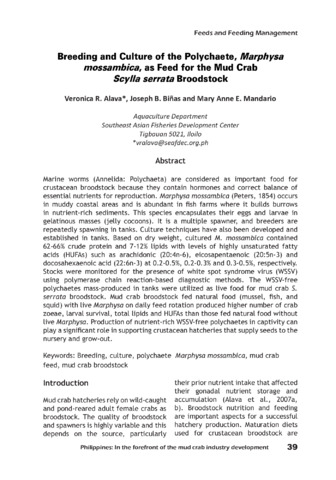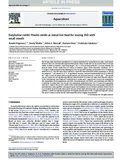Successful use of cryopreserved oyster trocophores as a live first feed larval marine fish and invertebrates
Share
Abstract
Trochophore-stage larvae of the Pacific oyster Crassostrea gigas were cryopreserved in bulk and stored in liquid nitrogen for periods up to two years before thawing and feeding to a variety of warmwater and coldwater larval marine fish, as well as to marine shrimps and other invertebrates. The commercial product ("TrochoFeed"), marketed in both pre-thawed and cryopreserved versions, has been used successfully in the early rearing of cultured species including red drum, snook, grouper, and black cod, as well as for numerous warmwater and coldwater aquarium display fish.
This paper describes the nutritional profile of the cryopreserved trochopores and presents a summary of the available growth and mortality data.
Suggested Citation
Harvey, B. J. (1996). Successful use of cryopreserved oyster trocophores as a live first feed larval marine fish and invertebrates. In C. L. Marte, G. F. Quinitio, & A. C. Emata (Eds.), Proceedings of the Seminar-Workshop on Breeding and Seed Production of Cultured Finfishes in the Philippines, Tigbauan, Iloilo, Philippines, 4-5 May 1993 (pp. 166-169). Tigbauan, Iloilo, Philippines: Aquaculture Department, Southeast Asian Fisheries Development Center.
Subject
Diets; growth rate  ; live feeds
; live feeds  ; mortality
; mortality  ; warm-water aquaculture
; warm-water aquaculture  ; feeds
; feeds  ; marine invertebrates
; marine invertebrates  ; spat
; spat  ; invertebrate larvae
; invertebrate larvae  ; molluscan larvae
; molluscan larvae  ; seed production
; seed production  ; fish larvae
; fish larvae  ; aquarium culture
; aquarium culture  ; Freezing storage; thawing
; Freezing storage; thawing  ; feed composition
; feed composition  ; marine fish
; marine fish  ; rearing techniques
; rearing techniques  ; nutritive value
; nutritive value  ; marine molluscs
; marine molluscs  ; Marine aquaculture; mortality causes
; Marine aquaculture; mortality causes  ; fish culture
; fish culture  ; Decapoda; Crassostrea gigas; Invertebrata; Pacific giant oyster; Philippines
; Decapoda; Crassostrea gigas; Invertebrata; Pacific giant oyster; Philippines
 ; live feeds
; live feeds  ; mortality
; mortality  ; warm-water aquaculture
; warm-water aquaculture  ; feeds
; feeds  ; marine invertebrates
; marine invertebrates  ; spat
; spat  ; invertebrate larvae
; invertebrate larvae  ; molluscan larvae
; molluscan larvae  ; seed production
; seed production  ; fish larvae
; fish larvae  ; aquarium culture
; aquarium culture  ; Freezing storage; thawing
; Freezing storage; thawing  ; feed composition
; feed composition  ; marine fish
; marine fish  ; rearing techniques
; rearing techniques  ; nutritive value
; nutritive value  ; marine molluscs
; marine molluscs  ; Marine aquaculture; mortality causes
; Marine aquaculture; mortality causes  ; fish culture
; fish culture  ; Decapoda; Crassostrea gigas; Invertebrata; Pacific giant oyster; Philippines
; Decapoda; Crassostrea gigas; Invertebrata; Pacific giant oyster; Philippines
Related items
Showing items related by title, author, creator and subject.
-
Approaches in Rebuilding Sea Urchin and Sea Cucumber Populations in the Philippines
Meñez, Marie Antonette J. (Training Department, Southeast Asian Fisheries Development Center, 2016)Sea urchins and sea cucumbers are among the most valuable and overexploited fishery resources. Culture and release of juvenile Tripneustes gratilla and Holothuria scabra have been undertaken to rebuild depleted populations ... -
Breeding and culture of the polychaete, Marphysa mossambica, as feed for the mud crab
Alava, Veronica R.; Biñas, Joseph B.; Mandario, Mary Anne (Aquaculture Department, Southeast Asian Fisheries Development Center, 2017)Marine worms (Annelida: Polychaeta) are considered as important food for crustacean broodstock because they contain hormones and correct balance of essential nutrients for reproduction. Marphysa mossambica (Peters, 1854) ... -
Euryhaline rotifer Proales similis as initial live food for rearing fish with small mouth
Hagiwara, Atsushi; Wullur, Stenly; Marcial, Helen S.; Hirai, Narisato; Sakakura, Yoshitaka (Elsevier, 2014)The SS-type rotifer Brachionus rotundiformis is a common initial food for rearing fish larvae with a small mouth. However, there are commercially important fish species whose mouth sizes are too small to feed on ...




